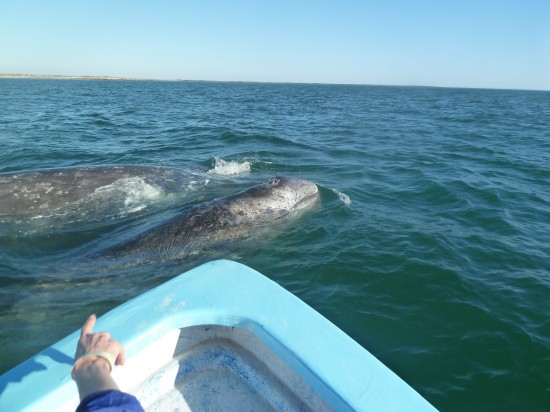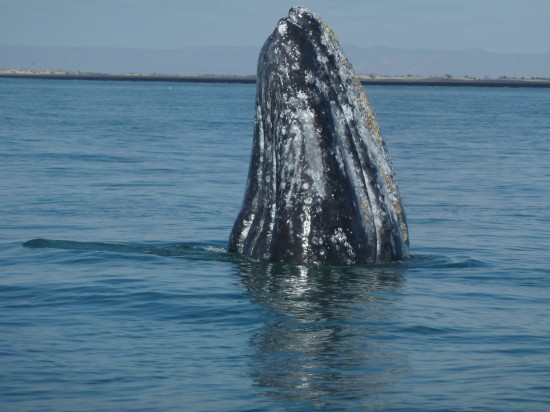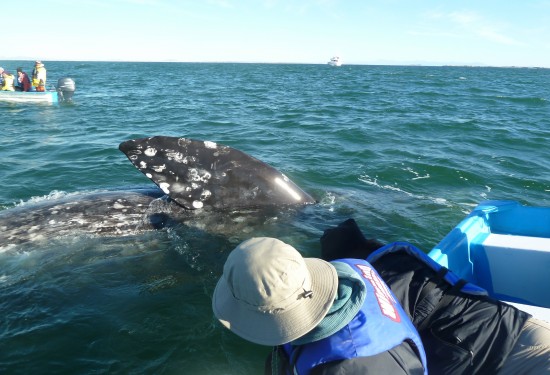 The Pacific Gray Whale undertakes the world’s longest mammal migration, traveling an average of 10,000 to 14,000 miles on its annual journey from northwest Alaska to the breeding and calving lagoons of Baja California. The whales are currently en route up the Pacific Coast, but memories of the time she spent among them in Baja this spring are still vivid in Wendy Redal’s mind.
The Pacific Gray Whale undertakes the world’s longest mammal migration, traveling an average of 10,000 to 14,000 miles on its annual journey from northwest Alaska to the breeding and calving lagoons of Baja California. The whales are currently en route up the Pacific Coast, but memories of the time she spent among them in Baja this spring are still vivid in Wendy Redal’s mind.
Part I: Save the Whales – and Save a Community at the Same Time
Crossing the spine of the San Francisco Mountains that divide the Sea of Cortez from the Pacific Ocean in Baja California Sur, I ponder the Jesuit missionaries who envisioned communities here in this hardscrabble desert. It’s a harsh yet aesthetic landscape, where spires of Cardon cactus rise toward a cloudless sky and empty arroyos haven’t seen a trickle of water in more than two years. We pass the occasional cow or horse, thin from a lack of vegetation to graze upon, eventually winding our way down from the brown slopes onto the flat coastal plain.
Just beyond an expanse of salt flats, we finally arrive at San Ignacio Lagoon. The bay glitters navy blue in the winter sunshine as we pull up to our beachside cabanas at the Kuyima whale camp, the simple eco-lodge that is our base for the next three nights on NHA’s Whales of Baja adventure.
Welcome to Our Whale Camp
Ahead is a scattering of small wooden cabins on stilts at water’s edge. Opposite is a solar-heated shower building and environmentally friendly bathroom facilities. To the north is the dining palapa, a thatched circular meeting place for meals and conversation. In the parking lot to greet us is Carlos Varela, head guide and camp manager, and all-around hospitality ambassador.
“Welcome to San Ignacio and Kuyima!” Carlos greets us, sharing one of many infectious smiles, usually accompanied by a joke, which we would come to enjoy over the next few days. We learn via Carlos how important our presence here is for the economic viability of the small fishing village here.
While we’ve long heard the call to “Save the Whales,” in this case, whales are helping to save a community and the environment that supports it. Local residents seek to make a living off the sea’s bounty much of the year, but they are facing problems from over-fishing and lack of other employment opportunities in this remote region. The lure of industrial development-related jobs in Baja is strong, but so far, residents here have rejected that avenue.
They have discovered that there is greater plenty in sharing its most famous residents – the Pacific gray whales — with the guests who come here between January and April each year. Conservation efforts that protect the whales and the wider ecosystem draw visitors seeking a pristine encounter with nature and wildlife, unmarred by the rampant beachfront development that has changed the face of places like Los Cabos on Baja’s southern tip.
The enterprise Carlos leads, Ecoturismo Kuyimá, is a local community-based organization that is a project of Ejido Luis Echeverría Álvarez, an association that occupies the lands southeast of San Ignacio Lagoon. Since 1990 the ejido (an ejido represents communally-owned lands by a large group of rural residents) has been developing ecotourism activities in central Baja in El Vizcaíno Biosphere Reserve, the largest natural protected area in Latin America.
Ejido Luis Echeverria Alvarez has negotiated a large-scale conservation easement of 140,847 acres. This easement restricts development activities on lands that the ejido controls, and will establish zoning for economic uses, buffer areas, and protected sites. This transaction is being closely monitored by the other five adjoining ejidos, who will decide if they would like to participate in other conservation easements in the future.
Meet the Gray Whales of Laguna San Ignacio
Foremost among the ecotourism activities offered by the ejido is the reason we are here: to see gray whales. These gentle giants, which often reach 40 feet long and 40 tons, migrate to this protected lagoon each winter to mate and give birth. Their journey is the longest annual migration of any mammal on earth, a round trip of 10,000 to 14,000 miles from the chilly waters off northwest Alaska.
Toward the end of November gray whales begin to migrate from the Bering Sea to Baja California. It takes them 5 to 8 weeks to reach their three wintering sites in Baja: San Ignacio and Ojo de Liebre lagoons and Magdalena Bay, where they breed and start raising their young. By mid-February the whales begin their return journey to Alaska, with adult males and females without offspring leaving first. Mothers with young calves stay longer in the warm, shallow waters, many not heading northward till the end of April, when the calves are ready to make the long swim.
Several hundred whales come to San Ignacio each winter, and most of them were still in the lagoon when our group arrived in late February. In fact, we were astounded at how many whales we saw. Each excursion in the panga – an open fishing skiff 23 feet long – lasted about two hours, out and back from camp, with 90 minutes among the whales. And each journey was a little bit different.
Close Encounters of the Cetacean Kind
On our first morning outing we were greeted by a series of spouts. Near and far, vertical shoots of spray erupted in the sky, creating dazzling rainbows in the whale-mist. Each was accompanied by a deep, hollow “Foooooshhhhh!” as the whale expelled water taken in with the krill and small organisms they eat, straining their food through the baleen plates in their capacious mouths. Gliding past us like submarines ascending to the surface, their mottled gray backs broke the water in a smooth arc as they rose for a breath.
After lunch we returned to the mouth of the lagoon, this time for a round of spy-hopping. For some reason we were seeing a great number of spy-hops – where a whale rises up vertically, poking its head up out of the water to take a look at things. Another excursion brought a fury of mating activity. In this case, a female whale entertains the affections of two or more males at a time, who take turns trying to impregnate her while thrashing about just below the surface. Our guides told us to keep an eye out for “Pink Floyd” – the local nickname for the male whale’s 6-foot-long reproductive organ, which is indeed bubble-gum pink. The name, and the quest to see the impressive bit of anatomy, brought raucous rounds of laughter every time we caught a glimpse.
While each outing brought more magical moments, my boat had not yet had a close-up connection in which we were able to touch a whale, although our other two boats had. [Let me note that generally, one would never seek to touch a wild animal — and in this case, our boats never pursue the whales — but there are whales within the lagoon that deliberately seek out human contact, and Mexican regulations within the reserve allow physical contact as long as the whale approaches the boat and not the other way around.] While such an encounter is never guaranteed, our turn came during the last two of our six panga excursions. We were graced with two extended visits by the same female whale – a “friendly,” as they’re called when they seek out human contact. In this case, she spent 45 minutes with us the first time and a full hour the next morning. Our guide could tell it was the same whale by the distinctive markings on her flipper.
What’s it like to touch a whale? Nothing quite prepares you for such a moment. To see this enormous creature, nearly twice the length of our boat, gliding beneath it, knowing she could up-end us in an instant if she wanted to, yet carefully coming alongside, trusting us, allowing us to stroke her – well, it’s profound. As I put my hand out and caressed her dark gray and white mottled skin, I was struck by how firm and rubbery it felt, except where barnacles sometimes attach. I was surprised to feel tears spring to my eyes when I made contact – it was just, simply, amazing. At one point I was able to trace the line of her mouth, my fingers gently following the inside of her long lip. Some of our group actually leaned out of the boat within close enough range to kiss the whale – try competing with those vacation snapshots!
I’ve always been captivated by animals and our relationships with them — but communing with friendly whales has taken that to a whole new level.
Filled with wonder,
Wendy
Check back on May 19 for Part II: the moving story of how the whales of Baja have helped one cancer survivor heal emotionally.
Why not consider some time among the whales yourself? Travel with Natural Habitat Adventures to see bears and whales (humpbacks, orcas and grays, all) on the BC coast in September, or, for a chance at close-up encounters like I had, come to Baja next spring when they return to Mexico, on Nat Hab’s Whales of Baja tour. Our springtime Yosemite and California Coast tour also offers a chance to see migrating grays offshore.
[All photos copyright 2011 by Wendy Worrall Redal unless otherwise noted.]
































It truly is a life changing and spiritual experience. There are no words to describe the joy one feels when meeting a whale up this close. It should be experienced by all. Thank you, Wendy, for a wonderful article that captures the experience.